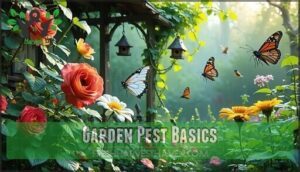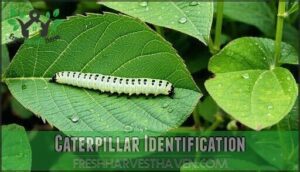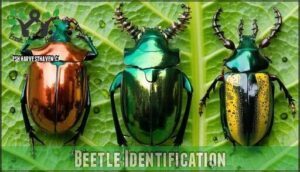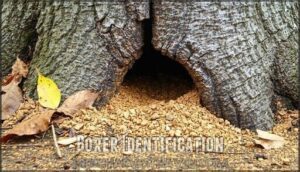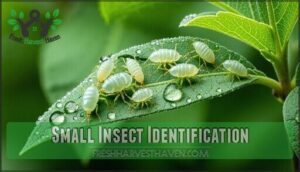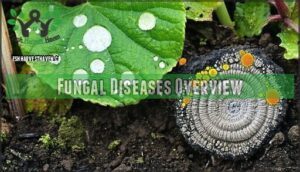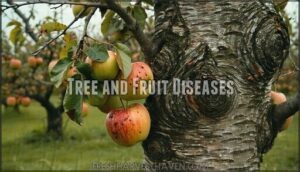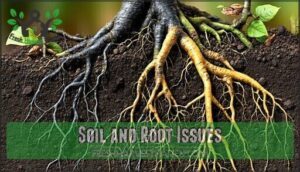This site is supported by our readers. We may earn a commission, at no cost to you, if you purchase through links.
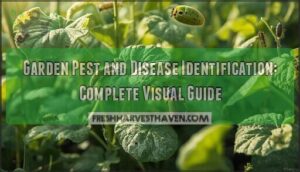
Look for chewed leaves (caterpillars or beetles), tiny holes (flea beetles), sticky honeydew (aphids), or wilting despite moist soil (root problems).
Disease symptoms include spots, powdery coatings, or sudden yellowing.
Check both leaf tops and undersides—many pests hide there.
Time of day matters too; slugs appear at night while aphids cluster during daylight hours.
Document what you find with photos for comparison guides.
The trick isn’t just spotting problems but distinguishing friend from foe in your garden ecosystem, which requires careful observation and documentation.
Table Of Contents
- Key Takeaways
- Garden Pest Basics
- Pest Identification Guide
- Disease Identification Tips
- Regional Pest Considerations
- Prevention and Control Measures
- Frequently Asked Questions (FAQs)
- How to identify pests in the garden?
- Where can I find information about insect pests & plant disease?
- How do I identify insect pests?
- How do I know if a plant has a pest?
- How do you identify pest damage?
- How do you know if a plant is damaged by insects?
- How do I identify pests in my garden?
- What is the most common pest in the garden?
- What are some of the diseases spread by garden pests?
- How do I identify my garden pest?
- Conclusion
Key Takeaways
- Examine damage patterns first – You’ll spot pest problems by looking for chewed leaves, tiny holes, sticky honeydew, or wilting despite moist soil, which tells you what type of pest you’re dealing with.
- Check both sides of leaves and timing matters – Many pests hide on leaf undersides, and you’ll catch slugs at night while aphids appear during daylight hours for accurate identification.
- Learn to distinguish beneficial insects from harmful ones – You can’t protect your garden effectively without knowing that ladybugs eat 50 aphids daily and parasitic wasps target caterpillars, so don’t accidentally harm your natural pest control team.
- Document everything with photos for comparison – You’ll need visual records to track pest patterns, compare damage over time, and use identification guides effectively for proper treatment decisions.
Garden Pest Basics
You’ll need to know the difference between friend and foe before you can protect your garden effectively.
Learning to spot common pests and beneficial insects saves you time, money, and helps you avoid accidentally harming the good guys who eat the bad ones.
Beneficial Insects Roles
Think of beneficial insects as your garden’s security team – they work around the clock to keep harmful pests in check.
Your garden’s natural bodyguards never clock out – they’re pest control pros working 24/7.
These natural predators create a balanced ecosystem that reduces your need for chemical interventions.
Ladybug Benefits shine when they devour up to 50 aphids daily.
Parasitic wasps excel at Parasite Control by targeting caterpillars and scale insects.
Green lacewings tackle spider mites with precision.
Here’s how these Insect Allies support your garden:
- Biological Agents maintain natural plant-insect relationships
- Natural predators reduce pesticide dependency by 70%
- Pollinator Health improves fruit and vegetable yields
- Biological control works throughout the entire insect life cycle
- Diverse beneficial insects create sustainable pest management systems
Attract them with daisy and dill family flowers, plus shallow water sources.
Common Garden Pests
Several pests threaten your garden’s health, and recognizing them quickly makes all the difference. Aphids cluster on new growth, sucking plant juices and causing curled, yellowing leaves. These tiny insects multiply fast, making aphid control essential early on.
Early pest detection saves your entire harvest—spot aphids before they multiply into garden catastrophe.
Slugs and snails leave shiny trails while chewing irregular holes through leaves and stems, especially during wet weather. Garden mites create stippled, bronzed foliage with fine webbing underneath leaves.
Wireworm management proves challenging since these root-feeding larvae live underground year-round. Smart gardeners use pest traps and regular monitoring for effective garden pest identification and slug removal strategies.
| Pest | Primary Damage |
|---|---|
| Aphids | Stunted growth, curled leaves |
| Slugs/Snails | Irregular holes, slime trails |
| Garden Mites | Stippled, bronzed leaves |
Pest Identification Methods
Now that you’ve spotted common garden pests, proper garden pest identification requires the right tools and techniques.
Effective pest identification methods help you catch problems early, before they spiral out of control.
- Use a magnifying glass for detailed insect ID and symptom diagnosis
- Set up sticky traps to monitor flying pests and track activity patterns
- Examine plants with a flashlight during evening hours for nocturnal feeders
- Take photos for your pest identification guide and compare damage over time
- Keep a garden journal to record pest signs, damage assessment, and treatment results
These garden pest detection strategies give you the upper hand in pest tracking.
Understanding common garden pests is essential for effective pest management and control.
Pest Identification Guide
Identifying garden pests correctly is your first step toward protecting your plants and choosing the right treatment method.
This guide breaks down common pest categories by size, appearance, and damage patterns to help you spot troublemakers before they take over your garden, which is a key part of protecting your plants.
Caterpillar Identification
Identifying caterpillar Larvae Types starts with examining your plants for telltale Caterpillar Damage patterns. Understanding their Pest LifeCycle helps you spot these Leaf Eaters before they multiply, making Worm Control much easier.
Effective garden maintenance involves using biological pest control methods to prevent infestations.
- Look for irregular holes in leaves with dark green frass (droppings) on lower foliage
- Check for rolled or tied leaves, which signal leafroller caterpillars are actively feeding
- Inspect stems at soil level for cutworm damage—they’ll chew right through young plant bases
Beetle Identification
Moving from caterpillars to beetles, you’ll encounter harder-bodied pests with distinctive features.
Japanese beetles sport metallic green bodies with copper wing covers, while Colorado potato beetles show yellow-and-black stripes. Cucumber beetles appear yellow with black spots or stripes.
| Beetle Types | Identification Tips | Beetle Damage |
|---|---|---|
| Japanese beetle | Metallic green, 12-15mm | Skeletonized leaves |
| Colorado potato beetle | Yellow-black stripes, 10mm | Defoliated potato plants |
| Mexican bean beetle | Copper-colored, oval spots | Shot-hole leaf patterns |
Look for pest signs like chewed leaves or distinctive feeding patterns for proper beetle control.
Borer Identification
Tree borers are sneaky pests that damage plants from the inside out, making pest detection tricky.
You’ll spot these wood borer invaders by watching for telltale signs that scream trouble ahead.
- Check trunk bases – Look for small, round entry holes and fine sawdust piles beneath trees
- Examine stems carefully – Search for swollen areas, cracks, or unusual bark damage patterns
- Watch for wilting – Sudden branch dieback often signals root infestation or stem damage
- Inspect for frass – Wood shavings mixed with larval identification clues like tiny pellets indicate active boring
Understanding pest lifecycle patterns is essential for effective pest management and prevention.
Small Insect Identification
Among garden insect pests, aphid control becomes essential when you spot these tiny, pear-shaped creatures clustering on new growth.
Spider mites create fine webbing while sucking plant juices, and whitefly management requires immediate attention when clouds of white insects emerge from disturbed plants.
| Insect | Size | Key Symptoms |
|---|---|---|
| Aphids | 1/16-1/8 inch | Curled leaves, sticky honeydew |
| Spider Mites | 1/50 inch | Stippled yellow leaves, fine webs |
| Whiteflies | 1/16 inch | Yellowing, wilting, virus spread |
| Scale Insects | 1/8 inch | Hard bumps, yellowing foliage |
Disease Identification Tips
Plant diseases often masquerade as nutrient deficiencies or environmental stress, making accurate identification essential for effective treatment.
You’ll need to examine symptoms carefully, considering factors like leaf patterns, growth stages, and environmental conditions to distinguish between fungal, bacterial, and viral infections that can devastate your garden.
Fungal Diseases Overview
Fungal infections can wreak havoc on your garden if you don’t catch them early.
These sneaky plant diseases thrive in humid conditions and spread quickly through spores.
- Powdery Mildew: White, dusty coating on leaves and stems
- Leaf Spot: Dark, circular patches that cause yellowing
- Rust Control: Orange pustules on leaf undersides
- Downy Mildew: Yellow spots with gray fuzz beneath
- Root Rot: Black, mushy roots from waterlogged soil
To prevent these issues, understanding fungal disease control is essential for maintaining a healthy garden.
Bacterial and Viral Infections
Your garden’s bacterial and viral infections demand swift action. Fire Blight blackens shoots, while mosaic plant viruses create mottled leaves. Bacterial wilt causes sudden collapse, and viral infections spread through insects or contaminated tools.
| Disease Type | Key Symptoms | Primary Cause |
|---|---|---|
| Fire Blight | Blackened shoots, wilting | Bacterial infection |
| Mosaic Virus | Mottled, yellow leaves | Virus transmission |
| Bacterial Wilt | Sudden plant collapse | Bacterial infections |
| Leaf Curl | Distorted, curled foliage | Plant viruses |
| Aster Yellows | Stunted, yellow growth | Bacterial infection |
Unlike fungal infections or Powdery Mildew, these diseases can’t be cured—only managed through removal. Understanding disease diagnosis methods is essential for effective garden management.
Tree and Fruit Diseases
Protecting your orchard starts with recognizing common threats that can devastate entire crops. Fruit tree diseases strike when you least expect them, turning healthy harvests into costly disasters.
Here’s how to spot the major culprits:
- Apple Scab – Dark, velvety spots on leaves and Fruit Rot with scabby lesions
- Fire Blight – Tree Blight causing blackened shoots that look burned
- Brown Rot – Rapid fruit collapse with tan spore rings during humid weather
- Canker Diseases – Bark Disease creating sunken, discolored trunk areas
- Peach Leaf Curl – Distorted, reddish leaves with thick, puckered texture
Watch for gummosis, sudden Leaf Spot patterns, and fruiting body formations on bark.
Soil and Root Issues
Identifying underground troublemakers requires sharp detective skills when root damage strikes your garden.
Root Rot appears as blackened, mushy roots, while Nutrient Deficiency shows through yellowing leaves.
Soil Compaction creates hard-packed earth that stunts growth, and Water Logging drowns roots in soggy conditions.
Soil Erosion exposes vulnerable root systems.
Proper plant disease diagnosis starts with examining soil health to prevent these fungal plant diseases.
Regional Pest Considerations
Your garden’s location determines which pests and diseases you’ll encounter most frequently, as climate, humidity, and native species vary dramatically across regions.
Understanding these local patterns helps you prepare targeted prevention strategies and choose the most effective control methods for your specific area, which is crucial for maintaining a healthy garden with effective control over pests and diseases.
Physical Controls and Barriers
After identifying diseases in your garden, building strong defenses becomes your next priority. Physical controls offer immediate protection without chemicals, giving you control over pest invasions.
Row Covers shield vulnerable seedlings from flying insects and weather extremes. Netting Barriers create protective domes over berry bushes and fruit trees. Fence Installation keeps deer and rabbits from treating your garden like a buffet. These barriers form your first line of defense in garden pest control.
Smart pest management combines multiple physical controls for maximum effectiveness:
- Copper tape around raised beds creates slug-proof zones
- Sticky yellow cards trap whiteflies and aphids mid-flight
- Cardboard collars around stems block cutworm attacks
- Crop Guards made from mesh protect individual plants
- Repellent Plants like marigolds naturally deter harmful insects
These ecofriendly solutions work immediately and last for seasons. Using row cover materials can provide additional protection for your plants.
Beneficial Insects and Regional Factors
Throughout your region, beneficial insects like ladybugs and parasitic wasps naturally control pests, but their availability varies by location.
Ladybug roles include targeting aphids and whiteflies, while parasite control specialists hunt caterpillars.
Regional pests shift with climate zones, making insect identification essential.
Insect migration patterns affect native pollinators and predators seasonally.
Plant diverse flowers to attract these natural allies for effective pest management.
Local Pest Management Strategies
Building effective pest monitoring routines starts with understanding your local climate’s impact on pest cycles.
Crop rotation disrupts pest breeding patterns while soil remediation improves plant resilience.
Community gardens share organic pesticides and techniques that work regionally.
Implement garden sanitation practices like debris removal and adopt integrated pest management strategies suited to your area’s specific pest pressures and beneficial insect populations.
Effective gardening also involves understanding natural pest control methods to minimize harm to the environment.
Prevention and Control Measures
Once you’ve identified garden pests and diseases, you’ll need effective strategies to stop them from spreading and causing more damage.
Prevention works better than treatment, so focusing on soil health, plant selection, and simple homemade solutions can save your garden before problems get out of hand.
Improving Soil Health and Airflow
Beneath your garden’s surface lies the foundation for plant health—robust soil structure and proper airflow work together to prevent disease before it starts.
Soil Aeration transforms compacted earth into a thriving garden ecosystem where roots breathe freely and beneficial microbes flourish. Organic Matter from compost boosts soil porosity while Mulch Benefits include moisture retention and pathogen splash prevention.
Here’s your soil improvement game plan:
- Apply Compost Tea monthly to feed beneficial microorganisms in the Root Zone
- Cultivate soil in spring to break compaction and improve plant airflow
- Layer organic mulch around plants to enhance plant soil structure and suppress weeds
Using a soil aeration tool can help improve soil health.
This foundation supports robust plant health naturally.
Using Resistant Plant Varieties
Smart gardeners skip the spray bottle by choosing disease resistant plants and pest resistant plants from the start.
Modern plant breeding programs create plant cultivars with built-in disease resistance and pest tolerance.
When selecting plant varieties, look for labels mentioning specific resistances. Crop selection based on variety development research saves time and reduces chemical treatments, making your garden naturally healthier.
Homemade Barriers and Fungicides
You’ll save money and protect your garden using DIY barriers and natural fungicides. Copper tape stops slugs with 75% effectiveness, while floating row covers cut pest damage by 80%.
Mix baking soda (1 tablespoon per gallon) for organic sprays against powdery mildew. Diatomaceous earth kills soft-bodied insects within 48 hours.
These homemade repellents offer reliable organic pest control without harsh chemicals. Effective pest control methods are essential for maintaining a healthy garden ecosystem.
Frequently Asked Questions (FAQs)
How to identify pests in the garden?
Look for visible damage patterns on your plants first.
Check leaves for holes, yellowing, or stippling, then examine stems and undersides for tiny insects, eggs, or webs that reveal the culprits.
Where can I find information about insect pests & plant disease?
You’ll find reliable information through university extension services, gardening websites like the University of Minnesota Extension, agricultural departments, and local Master Gardener programs that offer expert-backed pest and disease identification guides.
How do I identify insect pests?
Check for visible damage patterns first—look for chewed holes, stippled leaves, or sticky honeydew.
Then examine plant undersides, stems, and soil for actual insects, eggs, or telltale signs like webbing or slime trails.
How do I know if a plant has a pest?
Garden pests cause an 88% increase in damage inquiries annually. You’ll spot yellowing leaves, holes, sticky honeydew, webbing, or wilting plants that signal trouble’s brewing in your garden paradise.
How do you identify pest damage?
You’ll spot pest damage through telltale signs: chewed holes in leaves, yellowing or stippled foliage, slime trails, webbing, wilted plants, and visible insects clustering on stems or leaf undersides.
How do you know if a plant is damaged by insects?
Look for chewed holes, stippled leaves, curled foliage, and wilting plants. You’ll spot tiny insects clustering on stems, sticky honeydew residue, or telltale frass droppings beneath damaged areas.
How do I identify pests in my garden?
Examine leaves for holes, discoloration, or sticky residue.
Scout for tiny moving insects, webbing, or egg clusters.
Check stems and soil for damage patterns.
Follow slime trails to find slugs at night.
What is the most common pest in the garden?
Let me correct that response:
Slugs and snails steal the spotlight as your garden’s greatest troublemakers.
These slimy pests ranked number one in 2020, chewing irregular holes and leaving telltale shiny trails throughout your plants, and can be considered garden’s greatest troublemakers due to their actions, making them slimy pests and causing irregular holes.
What are some of the diseases spread by garden pests?
Garden pests spread several serious diseases that’ll wreck your plants.
Cucumber beetles transmit bacterial wilt, whiteflies carry viruses between plants, and aphids spread mosaic virus, causing mottled yellowing that stunts growth.
How do I identify my garden pest?
Check for visual clues like damage patterns, insect size, and location.
Aphids cluster on new growth, while caterpillars leave large holes and frass.
Note feeding times—slugs are nocturnal, leaving slime trails.
Conclusion
Tomorrow’s garden could be thriving—or struggling—depending on your garden pest and disease identification skills today.
You’ve learned to spot damage patterns, distinguish beneficial insects from harmful ones, and recognize disease symptoms early.
Remember, successful garden pest and disease identification requires consistent observation and documentation.
Check your plants regularly, photograph unusual symptoms, and don’t hesitate to research unfamiliar issues.
Your vigilance protects both your harvest and garden ecosystem health.

